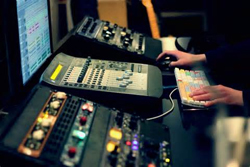
7. Document Everything. You’ll make it easier on yourself and your mastering person if everything is well documented, and you’ll save yourself some money too.
The documentation expected includes any flaws, digital errors, distortion, bad edits, fades, shipping instructions, and record company identification numbers. If your songs reside on hard disc as files, make sure that each file is properly ID’d for easy identification (especially if you’re not there).
Especially don’t be afraid to put down any glitches, channel imbalances, or distortion. The mastering engineer won’t think less of you if something got away (you wouldn’t believe the number of times it happens to everybody) and it’s a whole lot easier than wasting a billable hour trying to track down an equipment problem when the problem is actually on the mix master itself.
8. Alternate Mixes Can Be Your Friend. A vocal up, vocal down, or instrument-only mix can be a life-saver when mastering. Things that aren’t apparent while mixing sometimes jump right out during mastering and having an alternative mix around can sometimes provide a quick fix and keep you from having to remix. Make sure you document them properly though.
9. Check Your Phase When Mixing. It can be a real shock when you get to the mastering studio and the engineer begins to check for mono compatibility and the lead singer or guitar disappears because something in the track is out-of-phase.
Even though this was more of a problem in the days of vinyl and AM radio, it’s still an important point since many so-called stereo sources (such as television) are either pseudo-stereo or only stereo some of the time. Check it and fix it before you get there.
10. Go To The Session If At All Possible. Most engineers and producers will go to the first few sessions when checking out a new mastering engineer to see if he has the same musical and technical sensibilities. After that, a bond of trust develops and they will simply send the mix master with any instructions.
That being said, you should go to all of the mastering sessions if possible because it will always sound a bit different (and probably better) than what it sounded like during mix-down. Attending the session also allows for some final creative decisions that only you can make. (“The kick is a little loud, see if you can de-emphasize it a bit.” “Let’s squash the whole mix a little more to make this tune punchier.”)
11. Come Prepared. Make sure all documentation, shipping instructions and sequencing is complete before you get there. Sequencing (the order that the tunes appear on the CD or vinyl record) is especially important and doing this before hand will save you a bunch of money in mastering time.
Many engineer/producers have the mistaken impression that once the final mix is finished, it’s off to the mastering studio. There should be one additional session, however, known as the “sequencing session”. This means that you take a day and do any editing that is required (cheaper to do it here than during mastering) and listen to the various sequence possibilities.
This is really important if you will be releasing in multiple formats such as CD and vinyl (yes, there are still some die-hards) or different countries or territories since they will probably require a different song order due to the two sides of the record.
12. Have Your Songs Timed Out. This is important for a couple of reasons. First, you want to make sure that your project can easily fit on a CD, if that’s your release format. Most CDs have a total time of just under 80 minutes (78:33 to be exact) although it is possible to get an extended time CD (be careful, you may have replication problems). Obviously the available time decreases if you choose to include additional files on the ROM section of the disc.
13. Vinyl Records May Be Around For A While (But In Limited Quantities), So The Following Applies If You Intend To Cut Vinyl. Cumulative time is important because the mastering engineer must know the total time per side before he starts cutting due to the physical limitations of the disc. You are limited to a maximum of about 25 minutes per side if you want the record to be nice and loud.
Since you can only have 25 minutes or less on a side, it’s important to know the sequence before you get there. Cutting vinyl is a one-shot deal with no undo’s like on a workstation. It’ll cost you money every time you change your mind.
Bobby Owsinski is an author, producer, music industry veteran and technical consultant who has written numerous books covering all aspects of audio recording. For more information be sure to check out his website and blogs. Get the 2nd edition of The Audio Mastering Handbook here.
